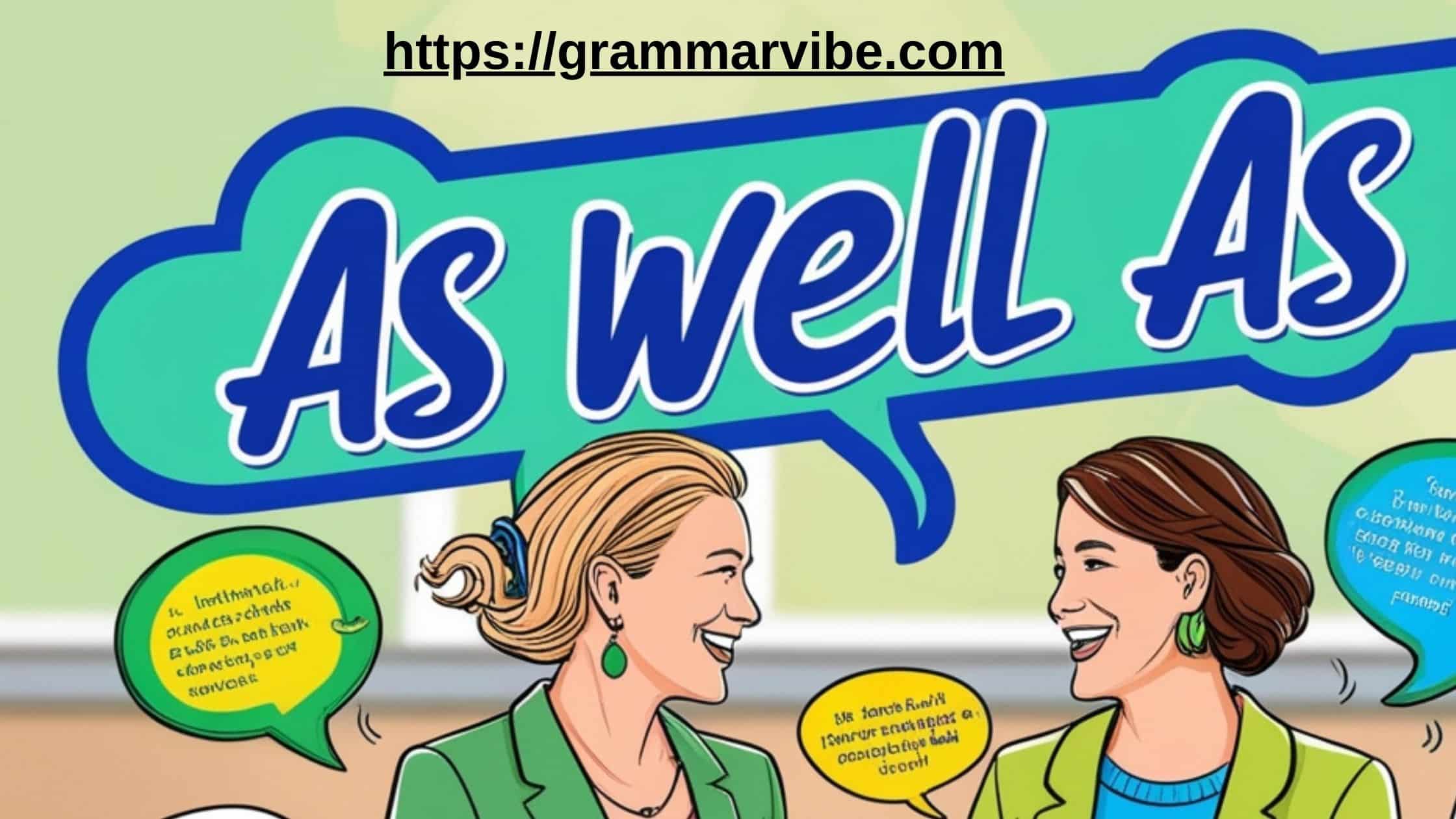In both personal and professional settings, repetition can sometimes make communication feel a little stale. One such example is the phrase “as well as.” While it’s useful, overusing it can make writing and speaking sound redundant. Fortunately, English offers numerous creative alternatives to spice up your communication and make it sound more dynamic.
Here, we’ll explore 15 other ways to say “as well as”—each with examples in various contexts, such as emails, presentations, and casual conversations.
1. In Addition To
“In addition to” is a versatile phrase that often implies an extra addition to something previously mentioned. It’s commonly used in both professional settings and casual conversations, making it perfect for showing how something adds value or support.
Example Scenario (Email):
Subject: Meeting Next Week
Hi Sam,
I wanted to confirm that we’re meeting next Tuesday at 10 AM. In addition to the agenda we discussed last week, I’ve added a few new points on team collaboration that we should review.
Looking forward to it,
John
2. Along With
“Along with” introduces an additional item or person related to the main subject. It’s often used when mentioning someone’s accomplishments or contributions that complement the primary focus.
Example Scenario (Presentation):
“Today, we’ll be discussing the new marketing strategy. Along with the plan for digital ads, we’ll also touch on the timeline and the responsibilities of each team member.”
Here, “along with” emphasizes the supplementary points that will be covered alongside the main topic.
3. Besides
“Besides” is a great way to introduce extra information in a more casual manner. It’s often used in social settings or when expressing a secondary point that adds weight to the main idea.
Example Scenario (Casual Conversation):
“Not only did Jane complete the report, but she also took the lead in organizing the client meeting. Besides, she stayed late to ensure everything was in order.”
In this case, “besides” emphasizes how Jane’s efforts go above and beyond her original task.
4. Furthermore

“Furthermore” is often used in formal contexts to add information that strengthens the argument or idea already presented. It’s particularly common in academic writing and professional reports.
Example Scenario (Report):
“Her proposal has already received positive feedback. Furthermore, her suggestions align perfectly with the company’s vision for the upcoming fiscal year.”
In this example, “furthermore” helps reinforce how the proposal fits within the larger context of company goals.
5. Moreover
Similar to “furthermore,” “moreover” is a transitional phrase used to add information that intensifies or deepens the previous point. It’s slightly more formal but useful for demonstrating how additional points build on each other.
Example Scenario (Formal Letter):
“Your dedication to improving employee engagement is highly commendable. Moreover, your willingness to collaborate with multiple departments shows great leadership potential.”
“Moreover” serves to add another layer of praise to the initial compliment.
More for you: 15 Other Ways to Say “Nice to E-Meet You”
6. Not to Mention
“Not to mention” is often used to introduce a point that is so significant it doesn’t need further elaboration, making it a great tool for emphasizing something important.
Example Scenario (Casual Chat):
“She’s a skilled marketer, not to mention her ability to build long-lasting client relationships.”
This phrase adds emphasis on an extra quality that might be understated without it.
7. Including
“Including” is used when listing items or people as part of a larger group, showing that one element is part of something more substantial.
Example Scenario (Email to a Client):
“I’ll be sending over the finalized proposal by Friday, including detailed budget estimates and timelines for each phase.”
Here, “including” is used to clarify what the proposal will encompass beyond the main document.
For your interest: 15 Other Ways to Say “I Look Forward to Speaking With You”
8. Together With
“Together with” emphasizes collaboration or combination, ideal for acknowledging how things work in harmony.
Example Scenario (Meeting Invitation):
“We’ll discuss the new marketing strategy, together with our objectives for the upcoming quarter, in tomorrow’s meeting.”
This shows that both elements of the meeting agenda are linked and will be addressed together.
9. Coupled With
“Coupled with” suggests a strong connection between two elements, often implying that they enhance each other. This phrase is useful in both formal and business contexts.
Example Scenario (Business Report):
“His expertise in data analysis, coupled with his ability to lead teams effectively, has significantly improved our performance.”
In this case, “coupled with” highlights the synergy between two qualities.
10. Aside From
“Aside from” is another way to introduce an additional point or idea. It’s particularly useful for introducing something that’s different but still important.
Example Scenario (Casual Conversation):
“Aside from her achievements in sales, she’s also been instrumental in fostering a positive team culture.”
This introduces another aspect of the person’s contributions, beyond the obvious achievements.
You might also like: 15 Other Ways to Say “How Is Your Day Going?”
11. That Works For Me
This is a conversational alternative to “as well as” that expresses flexibility and agreement. It’s often used when discussing plans or suggesting ideas in a collaborative setting.
Example Scenario (Email to a Team Member):
“Let’s meet at 3 PM, and that works for me for the presentation as well.”
Here, “that works for me” shows that the speaker is open to the plan.
12. I’m On Board

“I’m on board” is a straightforward phrase that signals approval or support. It’s often used to express agreement or consent, especially in team settings.
Example Scenario (Project Discussion):
“Everyone seems to agree on the new approach for the campaign, and I’m on board with it too.”
This highlights a strong sense of agreement and support for the idea being presented.
13. I’m In Agreement
Similar to “I’m on board,” “I’m in agreement” explicitly states that you fully support the idea or proposal.
Example Scenario (Business Proposal):
“I reviewed the proposal, and I’m in agreement with the direction we’re taking.”
This reinforces alignment and confirms the speaker’s support.
14. That Suits Me
“That suits me” is a more casual, yet effective way to express that something is acceptable and works well for you.
Example Scenario (Scheduling):
“The meeting time of 2 PM works for me. That suits me perfectly.”
This phrase is often used in everyday conversations and reflects flexibility.
Check out this: 15 Other Ways to Say “I Agree with You” Formally
15. I’m Amenable To That
“I’m amenable to that” is a slightly more formal way of showing that you’re open to a suggestion or idea, without being too assertive.
Example Scenario (Team Collaboration):
“After discussing all options, I’m amenable to that plan for the project.”
Here, it shows openness to the idea presented, signaling a positive response without complete enthusiasm.
Synonyms Table for “As Well As”
| Alternative Phrase | Example | Usage Context |
|---|---|---|
| In addition to | “In addition to his skills, he’s a great communicator.” | Formal & informal settings |
| Along with | “Along with her hard work, her dedication stands out.” | Professional environments |
| Besides | “Besides the technical skills, his creative solutions shine.” | Casual conversations |
| Furthermore | “Furthermore, we need to address the budget for the new project.” | Business and academic |
| Moreover | “Moreover, her approach is both innovative and practical.” | Formal writing & presentations |
| Not to mention | “Not to mention her previous experience in a similar role.” | Informal conversation |
| Including | “The report includes all the necessary details for the presentation.” | Official communication |
| Together with | “Together with his design, we have a winning project.” | Collaborative work |
| Coupled with | “His skills, coupled with his leadership, make him invaluable.” | Business and leadership roles |
| Aside from | “Aside from his technical skills, he excels in teamwork.” | Casual or professional setting |
Conclusion
When it comes to expressing ideas, plans, or agreements, using a variety of phrases can enhance both your communication and relationships. Whether you’re in a professional setting or casual conversation, incorporating alternatives to “as well as” will keep your language fresh and engaging. By choosing phrases like “in addition to”, “coupled with”, or “not to mention”, you add depth, flexibility, and creativity to your communication, while ensuring you come across as both supportive and open to suggestions.
Incorporating these alternatives will not only make your speech and writing sound more dynamic, but it will also help foster teamwork, collaboration, and positive reinforcement—qualities that lead to stronger group decisions and effective communication.

Kyren Paul is an experienced blogger and the creative mind behind “Grammar Vibe.” With a passion for the nuances of English grammar, he brings clarity and insight to everyday language topics, making grammar accessible and engaging for readers of all levels.











Leave a Comment